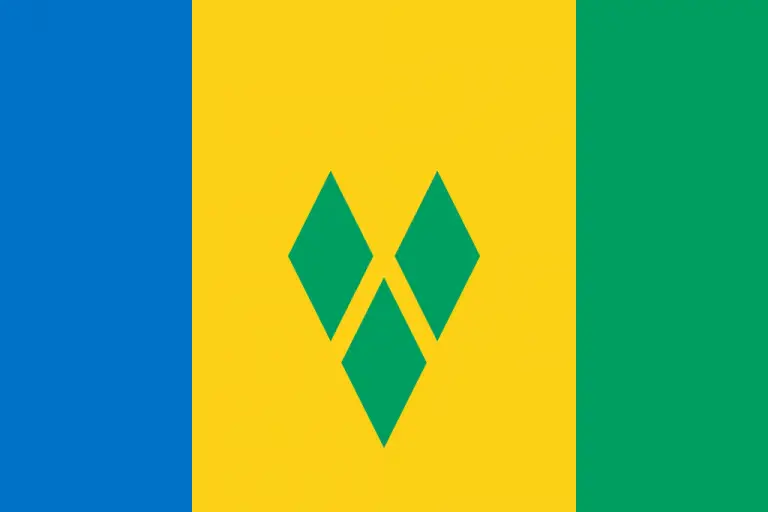
St Vincent and the Grenadines is a tropical paradise, made up of a string of 32 islands in the eastern Caribbean Sea. It consists of the island of Saint Vincent and the northern Grenadine islands.
Of the 32 islands and cays that make up St Vincent and the Grenadines, only nine are inhabited.
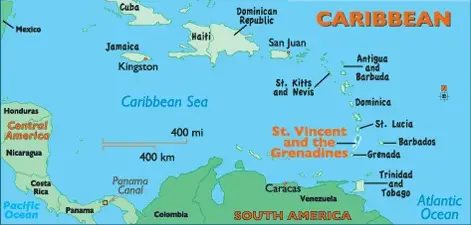
SHORT FACTS ON ST VINCENT AND THE GRENADINES !!!
- OFFICIAL NAME = SAINT VINCENT AND THE GRENADINES
- NATIONALITY = SAINT VINCENTIAN(S) OR VINCENTIAN(S)
- LOCATION = CARIBBEAN SEA
- CAPITAL = KINGSTON
- CONTINENT = NORTH AMERICA
- OFFICIAL LANGUAGE = ENGLISH
- POPULATION = 110,399
- CURRENCY = EAST CARIBBEAN DOLLARS
- AREA = 389 SQ KM (150 SQ MILES)
- HIGHEST POINT = LA SOUFRIERE 1,234 m (4,049 ft)
- MAIN RIVER = COLONARIE RIVER
- MAIN MOUNTAINS = LA SOUFRIERE AND GRAND BONHOMME
- CLIMATE = TROPICAL (HOT & HUMID)
- CALLING CODE = DIAL 011+784+PHONE NUMBER
- DRIVES ON = LEFT HAND SIDE OF THE ROAD
- RELIGION = MAINLY CHRISTIAN
- INDEPENDENCE = 27th OCTOBER, 1979 (FROM BRITAIN)
- NATIONAL HOLIDAY = INDEPENDENCE DAY, 27th OCTOBER
- GOVERNMENT = PARLIAMENTARY DEMOCRACY
- HEAD OF STATE = KING CHARLES III
- MAIN SPORT = SOCCER, ATHLETICS AND NETBALL
- MAJOR INDUSTRIES = AGRICULTURE, FLOUR MILLING, TOURISM, FORESTRY AND RUM DISTILLING
- MAIN EXPORTS = BANANAS, COPRA, STARCH AND TARO
- NATURAL RESOURCES = HYDROPOWER AND CROPLAND
- AGRICULTURE = BANANAS, VEGETABLES, COCONUT AND SUGAR
A BRIEF HISTORY OF SAINT VINCENT AND THE GRENADINES !!!
Saint Vincent and the Grenadines were one of the last Caribbean islands to be colonized by the Europeans. This was mainly due to the Carib Indians, who were the inhabitants of the islands at the time. They were aggressive, and had sufficient force to hold of their intruders until the eighteenth century.
The Caribs, along with escaped slaves from neighboring islands merged to form a new ethnic group, know as the Black Caribs, whose descendants can be found living on the islands today.
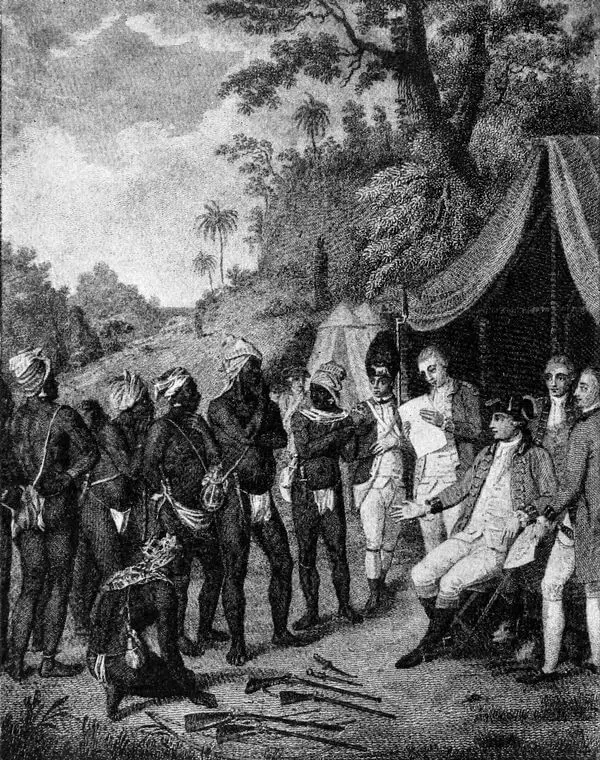
The French were the first European country to gain control of the island in 1719. They began cultivating coffee, tobacco, sugar and cotton on plantations, using enslaved Africans as the workforce.
In 1763, after a series of battles with the British, this led to the Treaty of Paris, which granted St Vincent to the British.
The French would briefly assume control of the island once again from 1779-1783, until it was restored back to Britain, by the Treaty of Versailles in 1783.
Just like the French before them, the British also shipped in African slaves to work mainly in the sugar and tobacco plantations.
Slavery was finally abolished in 1834, resulting in labor shortages on the plantations. To fix this, Portuguese and Indian workers were brought in increase productivity.
In 1902, the La Soufriere Volcano, located near the northern tip of the main island of St Vincent, violently erupted, killing 1,700 people and completely destroying the countries crops.
On Oct 27th, 1979, the island of St Vincent was granted full independence, although it became a constitutional monarchy, with King Charles III as head of state.
Shortly thereafter, the political entity became known officially as St Vincent and the Grenadines. This was after most of the smaller islands had sought individual independence.
INTEReSTING FACTS !!!
Saint Vincent and the Grenadines is a group of islands, situated in the Caribbean Sea. It lies to the south of Saint Lucia, the west of Barbados and north of Grenada. It’s part of a region called the West Indies.
Of the 32 islands and cays that make up St Vincent and the Grenadines, only nine are inhabited.
A cay is a sand island located on the surface of a coral reef.
The main inhabited islands of the Grenadines are called, Mustique, Union island, Bequia and Canouan. The others are privately owned. Lucky suckers.!!!!
Their name was bestowed by Christopher Columbus on his discovery of the islands in 1498.
St Vincent of Saragossa was a Spanish saint, and “Grenadines” derives from the Spanish word for “pomegranate,” which symbolizes the smaller islands (early settlers thought the island’s shape to be that of the fruit).
The main island of Saint Vincent was originally called “Youloumain” by it’s early inhabitants.
The main island of Saint Vincent is 29 km (18 miles) long, and 18 km (11 miles) wide. It has a rugged mountainous terrain covered by lush forests.
Saint Vincent and the Grenadines has a total stunning coastline of 84 kilometers (52 miles).
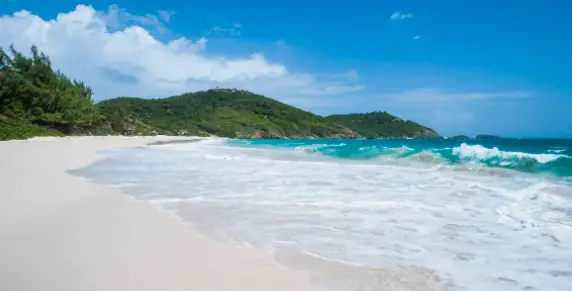
All of the Grenadine islands are famous for their white beaches and rich greenery.
Half of the population of Saint Vincent and the Grenadines live in rural areas, of which 25% are employed in farming.
The climate of Saint Vincent and the Grenadines is tropical. Although it is hot and humid all year round, from December to April is probably the best time to visit, as the nights are a wee bit cooler.
The highest point on St Vincent is the volcanic peak of “La Soufriere.” It reaches a height of 1,234 meters (4,049 ft), and also has a lake in the crater.
The massive Volcano, La Soufriere, takes up one third of the island of St Vincent. It last erupted in 1979, but when it erupted in 1902, it killed nearly 2,000 people and totally destroyed all their plantations.
On Friday, April 9th, 2021, around 16,000 people had to flee their ash-covered communities after the latest eruption of La Soufriere on the Caribbean island of St Vincent. Explosions and accompanying ashfall is expected over the next few days as the volcano continues to erupt. Thankfully, there is no reports of anyone being killed or injured by the initial blast or those that followed.
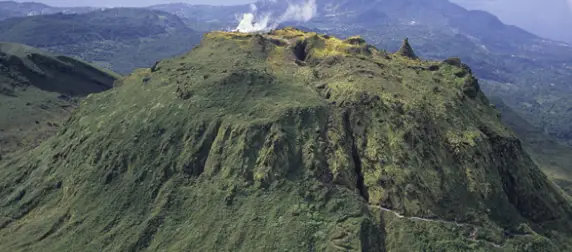
Many Volcanoes in the Caribbean are called Soufriere (French for “Sulphur outlet”).
Saint Vincent and the Grenadines are unfortunately in the Atlantic Ocean Hurricane Belt, therefore, they are prone to flash floods and hurricanes almost every year.
Due to numerous volcano eruptions, as well as deforestation in Saint Vincent and the Grenadines, it’s wildlife was badly effected. However, it is not completely bare, so you will get to see some wildlife, such as the Lesser Antillean whistling frog, cane toads, lizards, geckos and the common iguana. There is also several species of bats to be found here.
There are 5 airports and 7 ports of entry in Saint Vincent and the Grenadines. They are required for the tens of thousands of tourists that visits it’s shores every year.
Saint Vincent and the Grenadines is a tropical paradise and is a very popular destination for weddings and honeymoons. It has won numerous awards for the best honeymoon islands in the Caribbean.
With it’s lush natural beauty and stunning landscape, there’s plenty to see and do, once you arrive in Saint Vincent and the Grenadines. Whether it’s diving and snorkeling the beautiful reefs and shipwrecks, wandering the breathtaking botanic gardens, hiking the slumbering volcano or following the Vermont nature trail, you won’t be disappointed.
If you were to pop over to the small island of Mustique, you just might bump into a celebrity on holidays, who could pay up to $200,000 a week, just to stay there.
One of the most visited sites in Saint Vincent and the Grenadines is the Botanic Gardens in Kingstown. It is one of the oldest gardens of its kind in the tropical world. The protection of the most rarest species of plants has been going on here since 1765.
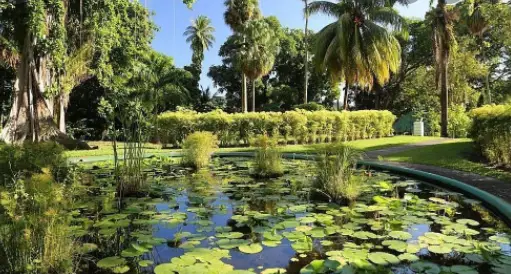
Saint Vincent and the Grenadines is a safe country to visit, as it has a very low crime rate. The locals are well known for their warm welcome and friendliness.
Bananas are big business in Saint Vincent and the Grenadines, accounting for up to 50% of the island’s income.
The national dish of Saint Vincent and the Grenadines is roasted breadfruit and fried jack fish.
The national flag of St Vincent and the Grenadines was officially adopted on Oct 12, 1985. The blue is a symbol of the sky and sea, gold is for the sunshine and the golden sand of the Grenadines, and green is for abundant vegetation. The Gems of Antilles (centered) are placed in the shape of a V, one that represents St Vincent.
Saint Vincent and the Grenadines, like many of the other small islands in the Caribbean, do not maintain a standing army. The Royal Saint Vincent and the Grenadine police force, which also includes the Coast Guard, Special Services Unit, Rapid Response Unit, Drug Squad, and the Anti-Trafficking Unit, are all responsible for maintaining national security.
Parts of the Pirates and the Caribbean movies were filmed here.
In Saint Vincent and the Grenadines, you’ll hear lots of lively Caribbean music, including reggae, calypso and soca.
The adult literacy rate in St Vincent and the Grenadines is 95.63%, while the life expectancy is 72.42 years.




